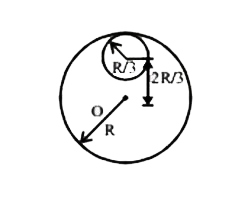A circular disc A of radius r is made from an iron plate of thickness t and another circular disc B of radius 4r is made from an iron plate of thickness t/4. The relation between the moments of inertia IA and IB is (about an axis passing through centre and perpendicular to the disc)
lA>lB
lA=lB
lA<lB
depends on the actul values of t and r
The correct Answer is:C
To solve the problem, we need to find the relationship between the moments of inertia IA and IB for the two circular discs A and B.
Step 1: Calculate the Moment of Inertia for Disc A
The moment of inertia I of a disc about an axis passing through its center and perpendicular to the disc is given by the formula:
I=12mR2
Where:
- m is the mass of the disc
- R is the radius of the disc
For disc A:
- Radius RA=r
- Thickness t
First, we need to calculate the mass mA of disc A. The mass can be found using the formula:
mA=Volume×Density=Area×Thickness×Density
The area of disc A is:
Area=πR2A=πr2
Thus, the volume of disc A is:
Volume=Area×Thickness=πr2t
So, the mass of disc A is:
mA=πr2t⋅ρ
Now substituting mA into the moment of inertia formula:
IA=12mAR2A=12(πr2t⋅ρ)r2=12πr4tρ
Step 2: Calculate the Moment of Inertia for Disc B
For disc B:
- Radius RB=4r
- Thickness tB=t4
Using the same process to find the mass mB:
The area of disc B is:
Area=πR2B=π(4r)2=16πr2
Thus, the volume of disc B is:
Volume=Area×Thickness=16πr2⋅t4=4πr2t
So, the mass of disc B is:
mB=4πr2t⋅ρ
Now substituting mB into the moment of inertia formula:
IB=12mBR2B=12(4πr2t⋅ρ)(4r)2=12(4πr2t⋅ρ)(16r2)=322πr4tρ=16πr4tρ
Step 3: Find the Relation between IA and IB
Now we have:
IA=12πr4tρ
IB=16πr4tρ
To find the ratio of IA to IB:
IAIB=12πr4tρ16πr4tρ
Cancelling out common terms:
IAIB=12⋅116=132
Thus, we find:
IA=132IB
Conclusion
From the above calculations, we conclude that:
IB=32IA
The moment of inertia I of a disc about an axis passing through its center and perpendicular to the disc is given by the formula:
- m is the mass of the disc
- R is the radius of the disc
- Radius RA=r
- Thickness t
For disc B:
- Radius RB=4r
- Thickness tB=t4
Now we have:
IB=16πr4tρ
From the above calculations, we conclude that:
Topper's Solved these Questions
- ROTATIONAL MOTIONBOOK - DC PANDEY ENGLISHCHAPTER - ROTATIONAL MOTIONEXERCISE - A Only One Option is Correct
86 Videos
- ROTATIONAL MOTIONBOOK - DC PANDEY ENGLISHCHAPTER - ROTATIONAL MOTIONEXERCISE - More than one option is correct
36 Videos
- ROTATIONAL MECHANICSBOOK - DC PANDEY ENGLISHCHAPTER - ROTATIONAL MECHANICSEXERCISE - Subjective Questions
2 Videos
- SEMICONDUCTORS AND ELECTRONIC DEVICESBOOK - DC PANDEY ENGLISHCHAPTER - SEMICONDUCTORS AND ELECTRONIC DEVICESEXERCISE - More than One Option is Correct
3 Videos
Similar Questions
A circular disc X of radius R is made from an iron of thickness t, and another disc Y of radius 4R is made from an iron plate of thickness t/4. Then the relation between the moment of mertia Ix and IY is :
View SolutionA uniform circular disc A of radius r is made from A copper plate of thickness t and another uniform circular disc B of radius 2r is made from a copper plate of thickness t/2. The relation between the moments of inertia IAandIB is?
View SolutionThe moment of inertia of a copper disc, rotating about an axis passing through its centre and perpendicular to its plane
View SolutionThe moment of inertia of a thin square plate ABCD of uniform thickness about an axis passing through the centre O and perpendicular to plate is

View SolutionA hole of radius R/2 is removed from a thin circular plate of radius R and mass M. The moment of inertia of the remaining plate about an axis through centre O and perpendicular to the plane of the plate is

View SolutionRadius of gyration of a uniform circular disc about an axis passing through its centre of gravity and perpendicular to its plane is
View SolutionThe mass of a disc is 700 gm and its radius of gyration is 20 cm. What is its moment of inertia if it rotates about an axis passing through its centre and perpendicular to the face of the disc?
View SolutionA disc has mass 9 m. A hole of radius R/3 is cut from it as shown in the figure. The moment of inertia of remaining part about an axis passing through the centre 'O' of the disc and perpendicular to the plane of the disc is :

View SolutionOne circular ring and one circular disc, both are having the same mass and radius. The ratio of their moments of inertia about the axes passing through their centres and perpendicular to their planes, will be
View SolutionCalculate the moment of inertia of a.unifprm disc of mass 0.4 kg and radius 0.1m about an axis passing through its edge and perpendicular to the plane of die disc ?
View Solution
